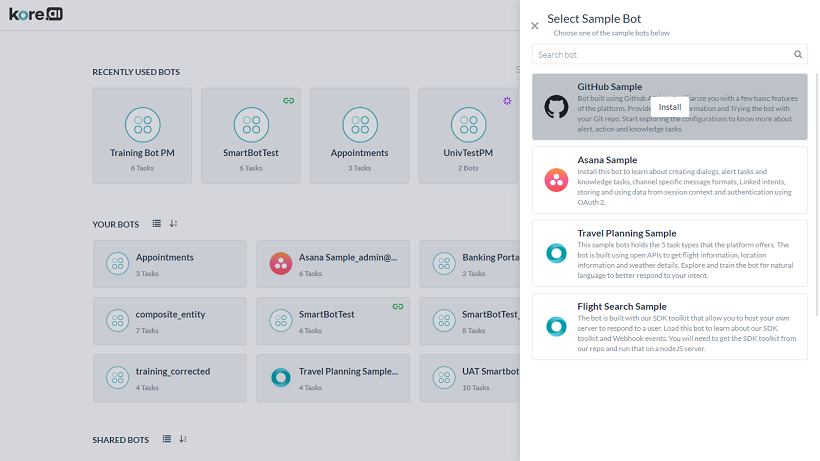To get you started with Bot Builder and Kore.ai bots, you can install a fully-defined sample bot that you can view, modify, and clone to explore end-to-end bot definitions.
Each sample bot is designed and defined to demonstrate most of the features of Kore.ai bots to include authorization setup, alert tasks, action tasks, dialog tasks, knowledge tasks, and various channels. These Bots also incorporate our SDKs that allow you to run Kore.ai bots in your applications as web services, or mobile operating systems.
To view your sample bots, click the down-arrow next to the +New Bot and select Install Sample Bots.
You can install one or more of the sample bots, and install multiple instances of each sample bot as needed.
To install a sample bot
- Log on to Bot Builder.
- To view your sample bots, click the down-arrow next to the +New Bot and select Install Sample Bots.
- Search and hover over a sample bot you want to install, and then click the Install button displayed.
- Setup instructions and configurations if any, depending on the sample bot selected, will be displayed.
For detailed installation, configuration, and description of sample Bots see:
- GitHub Sample – You can use this sample bot to access GitHub API’s and familiarize yourself with basic features of the Bots Platform, by defining authorization and exploring the task configurations for alert tasks and action tasks. For more information, see the Github Sample Bot.
- Asana Sample – You can use the Asana Sample bot to learn about creating dialog and alert tasks, as well as channel-specific message formats, linked intents, storing and using data from the session context object and authentication using OAuth 2. For more information, see the Asana Sample Bot.
- Travel Planning Sample – This sample bot is defined with two dialog tasks using open APIs to get flight information, location information and weather details. You can use this bot to learn about optimizing NLP and designing more complex dialog tasks., as well as an alert task, information task, action task, and knowledge task. For more information, see the Travel Planning Sample Bot.
- Flight Search Sample – This bot is based on the Kore.ai BotKit SDK that you can use to host the bot on your server to respond to a user using webhooks. This bot is based on a dialog task, and also has a knowledge task. For more information, see the Flight Search Sample Bot.

